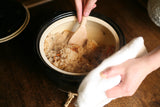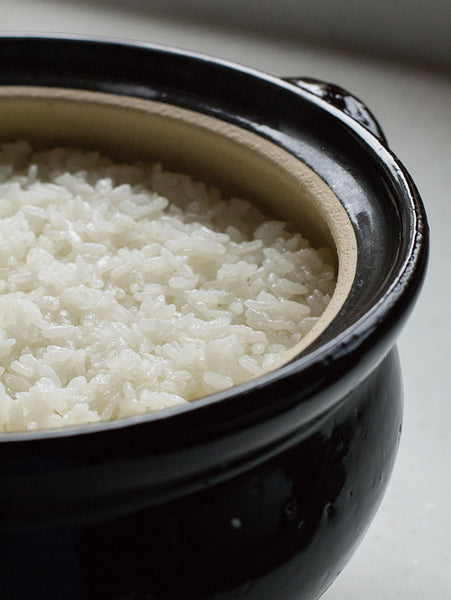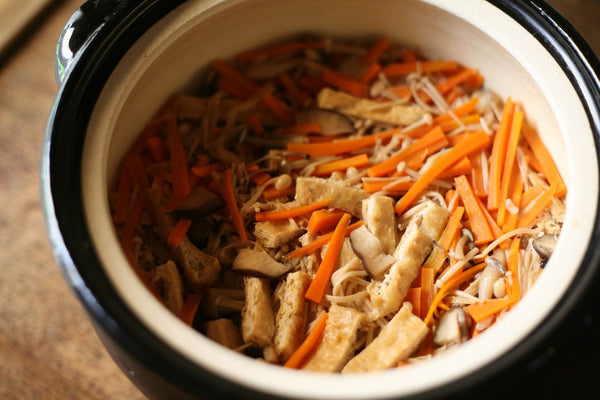Koiga Iga Earthenware Donabe Double Lid Rice Cooker
Koiga Iga Earthenware Donabe 3 Rice-Cups Cooker
Size: W25 × D22.5 × H18 cm, weighs 2.85kg including handles and lid
Capacity: 1.5 ltr
Ideal to cook up to 3 rice cups (about 2 ¼ imperial cups =540 ml) of rice.
Once you set the heat to medium-high level on the stove-top, you don’t need to readjust the heat level until it’s done. (The ideal heating level may vary depending on the type of burner.) The bottom of cooker is about 1.5 times thicker than a regular rice cooker and its porous clay body “breathes” during cooking. So, the clay builds the heat slowly and gently starts cooking the rice. Then, once the heat is built, it brings the even and steady heat distribution. Meanwhile, the unique feature of double-lid gives the effect of pressure-cooking and helps prevent the contents from boiling over. When the rice starts to boil, the rate of steam leaving the inner lid is faster than the amount of steam leaving the outer lid and the inner lid has two holes, whilst the outer lid only has one. This causes steam to accumulate in the compartment between the inner and outer lid, pushing the inner lid down and exerting pressure on the cooking rice.
The thick porous body has an extra-high level of heat retention ability, so after the heat is turned off, the cooker slowly cools down and continues to steam-cook the rice during the resting time. As a result, the rice tends to become fluffy and shiny when it’s cooked with the cooker.
Koiga Gohan-Nabe can also be used for making brown rice, mixed rice, soup, stews, hot pots and casseroles.
While Koiga Gohan-Nabe is particularly designed for making premium-quality rice, this beautiful donabe can also be used for other purposes, such as making soup, stew or hot pot without the inner lid.
Wonderful durability
Donabe from Iga is also known for its great durability. With your tender care , rice cooker can last for a long time. It will only add the nicer character to it.
All the donabe and Iga-yaki products are hand-crafted with care, so every piece is unique and no two pieces are identical. There are slight variations within the color/ shade, shape/ curve, and patterns, among pieces, and that makes each piece so special. Also under different lighting and angle, the actual color shade and nuance may also appear slightly different from the photos in the product page.
True “Terroir” of Iga
Iga region, where this donabe is made, used to be the bed of Lake Biwa about 4 million years ago. The clay from this region is naturally highly heat-resistant and has been used for open-flame cooking for many hundreds of years. This clay consists of a high level of pre-historic fossilised microorganisms that leave the clay porous when fired. The porous body gives the donabe remarkable heat-retention ability. The donabe gradually builds the heat when it’s heated, then it cools down very slowly after the heat is turned off. This, along with the glaze that promotes the far infrared rays (FIR – the same effect as how the glowing charcoal cook ingredients without direct flame) when it’s heated, allow the donabe to produce a gentle, steady heat that penetrates to the core of each ingredient. The effect is ingredients are cooked evenly with all the flavours sealed inside.
Instructions for cooking Japaneses white koshihikari rice:
The cooking ratio is: General recommended ratio of short grain white rice to water is 9:10. For each 1 rice cup (180 ml) of rice, the suggested water amount is 200 ml. Adjust the ratio according to your preference. (The ratio can be close to 1:1 for new crop rice with higher moisture level.)
Begin cook on medium-high heat until steam appears from the top of the outer lid ,around 15 minutes. Allow another minute or two before switching off the heat. Turn off the heat and let it stand with residual heat for 20 minutes before serving
The initial 15-20 minutes for first steam to appear is a good indicator of whether the cooking flame is too high or too low. If it appears too early in less than 15 minutes, the high heat, with risks of burning the pot underside. If steam appears only after more than 20 minutes, the heat is perhaps too low. Test and trial and it will get better with practice. Brown rice will require more cooking water and time.
Care Instructions
This donabe develops its character as it ages over time and use.
The very thin hairline cracks could appear on the surface (glaze) and exterior bottom of the donabe. These hairline cracks are known as “kannyu” in Japanese and they do not affect the function of the donabe. Kannyu is appreciated by the wabi-sabi aesthetic. It is a desired feature in Japanese pottery and is a characteristic of wabi-sabi.
The naturally developed cracks are a primary feature of hand made pottery vessels made naturally without using petalite. Mass-produced ceramic with added petalite will not develop hairline cracks on the glaze surface and have a perfect homogenous sheen.
With use over time, the bottom part starts to change its colour and black spots (like burned spots) could appear. It’s also the part of developing the character and the donabe is safe to use. However, if the bottom part seems to get too black too quickly, the heat you use might be too high. In this case, we suggest that you use the donabe over a lower heat level.
If rice was left in the claypot overnight or longer with acrid smell or mould growth, fill up the claypot to 80% of its maximum capacity with a handful of green tea leaves and water and bring to a boil. Tea leaf has an antioxidant effect. To get rid of stubborn mould growth, clean surface with 5 tablespoons of rice vinegar.
Material: Clay
Origin: Iga, Japan
Included in the package: Gohan nabe (bowl, inner lid, and outer lid) and English instruction sheet.
Ideal for gas stove top use.
This donabe is NOT suitable for electric or induction cooktop.
Oven-safe (up to 500℉/ 250℃).
This donabe is NOT suitable for microwave.
Hand wash only.
Before the first use, this Gohan-nabe must be seasoned according to 'medome' process - instructions provided.
























